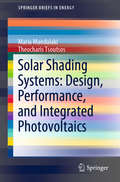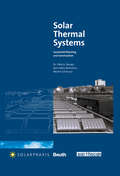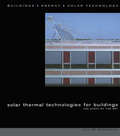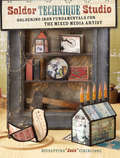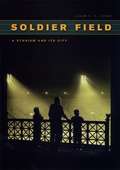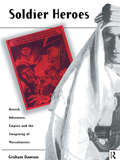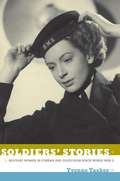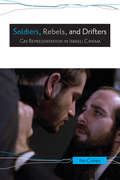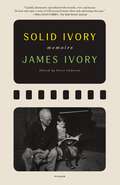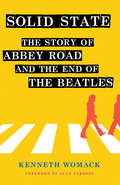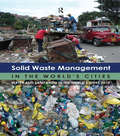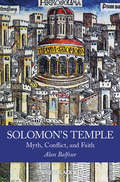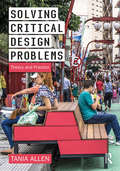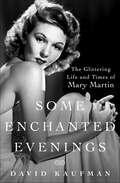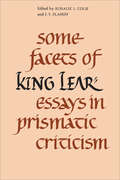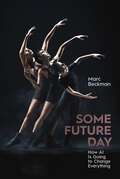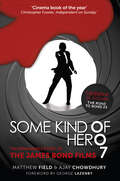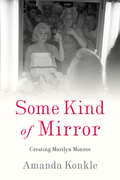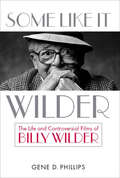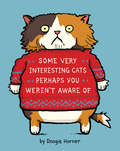- Table View
- List View
Solar Shading Systems: Design, Performance, and Integrated Photovoltaics (SpringerBriefs in Energy)
by Maria Mandalaki Theocharis TsoutsosThis is the first book to describe the development of and state of the art in solar shading devices in buildings, detailing all methods of evaluating shading systems according to thermal and visual comfort. The issue of energy balance in buildings is gaining importance as conventional energy sources dwindle and become more expensive. As such, environmental concerns should be considered in overall design decisions. The book discusses the role sun control “machines” play in controlling solar and thermal radiation. It examines their geometry, their position in relation to glazing and their operation (in the cases of movable systems) to control the heat and light entering a building, as well as how their material and color influence their performance. This book appeals to architects and designers who are interested in efficient energy facade design.
Solar Sketching
by Sally Russell Erika Rix Richard Handy Kim HayFrom the authors of Sketching the Moon comes a comprehensive guide filled with richly illustrated, detailed drawing tutorials that cover a variety of solar phenomena. Explanations of what to expect visually from white light, Hydrogen-alpha and Calcium K filters are provided for those new to solar observing, along with essential tips on equipment, observing techniques and the practicalities of drawing at the eyepiece. Time-honored, traditional methods and media are described in tandem with innovative techniques developed and shared by contemporary astronomical sketchers. For the technically minded, detailed descriptions are given on how to use image manipulation software to bring your sketches to life through animation. The Sun is the most visually dynamic object in our solar system and offers compelling, spectacular views. Knotted magnetic field lines give rise to powerful eruptions and form the intricate sunspots and arching prominences that make our nearest star one of the most exciting, yet challenging, astronomical objects to sketch. Facilitated by the availability of affordable dedicated solar telescopes and filters, the Sun has become an increasingly popular target amongst astronomical sketchers. The use of narrowband solar filters provides a wonderful opportunity to capture views of the Sun that have, until recently, been largely inaccessible. You'll discover easy to follow, step-by-step instructions geared toward your specific interests, be it technical sketching and contributing to science, personal study, or even fun solar outreach activities that help children learn through art. By using Solar Sketching as a reference, drawing the Sun has never been easier.
Solar Thermal Systems: Successful Planning and Construction
by Karl-Heinz Remmers Dr Felix Peuser Martin SchnaussSolar Thermal Systems summarizes the theoretical and practical knowledge gained from over 20 years of research, implementation and operation of thermal solar installations. This work provides answers to a variety of key questions by examining current solar installations, drawing upon past experiences and making proposals for future planning. - how do system components and materials behave under continuous operation? - which components have proven themselves and how are they used properly? - what are the causes of defects and how can they be avoided? - how long is the service life of modern solar installations? - what is the difference between the various solar collectors? - what performance can be expected from solar installations? - how are solar installations planned and structured correctly? In addition to practical recommendations on implementation, the theoretical background is also clearly explained. This book is a valuable guide for all those who deal with solar technology and at the same time a reference for the daily work of planners and fitters. It will also prove a useful tool for training and education.
Solar Thermal Technologies for Buildings: The State of the Art (BEST (Buildings Energy and Solar Technology))
by M. SantamourisSolar thermal is now a proven technology in terms of reliability, cost-benefit, and low environmental impact. The integration of solar thermal systems and installations into the design of buildings can provide a clean, efficient and sustainable low-energy solution for heating and cooling, whilst, taken in a wider context, contributing to climate protection. This book covers the state of the art in the application of solar thermal technologies for buildings. This is the first book in the BEST (Buildings, Energy and Solar Technology) Series. This series presents high-quality theoretical and application-oriented material on solar energy and energy-efficient technologies. Leading international experts cover the strategies and technologies that form the basis of high-performance, sustainable buildings, crucial to enhancing our built and urban environment.
Solder Technique Studio: Soldering Iron Fundamentals for the Mixed Media Artist
by Giuseppina CirincioneDiscover Soldering Secrets! Whether you've never soldered before or are used to using your soldering iron primarily for stained glass, you will discover a bounteous new world of artistic possibilities in Solder Technique Studio. Workshop instructor, artist and author, Giuseppina "Josie" Cirincione shares in-depth information about everything from materials for soldering and glass cutting to previously unpublished soldering techniques, such as attaching jump rings using two pieces of glass. Follow along with 14 step-by-step projects, such as a wall shelf, an eyeglass pendant, bottle topper, a glass book and so many more! Inside you'll find Thorough soldering and glass cutting techniques, including detailed descriptions of materials with step-by-step photographs. 14 dimensional projects shown step-by-step, and incorporating a variety of mixed-media materials such as previously brewed tea bags, pencils, alcohol inks and much more. Techniques and projects to use beyond mixed-media art, to include stained glass and jewelry work.
Soldier Field: A Stadium and Its City
by Liam T. A. FordSports fans nationwide know Soldier Field as the home of the Chicago Bears. For decades its signature columns provided an iconic backdrop for gridiron matches. But few realize that the stadium has been much more than that. Soldier Field: A Stadium and Its City explores how this amphitheater evolved from a public war memorial into a majestic arena that helped define Chicago. Chicago Tribune staff writer Liam Ford led the reporting on the stadium's controversial 2003 renovation- and simultaneously found himself unearthing a dramatic history. As he tells it, the tale of Soldier Field truly is the story of Chicago, filled with political intrigue and civic pride. Designed by Holabird and Roche, Soldier Field arose through a serendipitous combination of local tax dollars, City Beautiful boosterism, and the machinations of Mayor "Big Bill" Thompson. The result was a stadium that stood at the center of Chicago's political, cultural, and sporting life for nearly sixty years before the arrival of Walter Payton and William "The Refrigerator" Perry. Ford describes it all in the voice of a seasoned reporter: the high school football games, track and field contests, rodeos, and even NASCAR races. Photographs, including many from the Chicago Park District's own collections, capture these remarkable scenes: the swelling crowds at ethnic festivals, Catholic masses, and political rallies. Few remember that Soldier Field hosted Billy Graham and Martin Luther King Jr., Judy Garland and Johnny Cash--as well as Grateful Dead's final show. Now part of the city's bid for the 2016 Olympic Games, Chicago's stadium on the lake continues to make dramatic history. Soldier Field captures this history in the making and will captivate armchair historians and sports fans alike.
Soldier Heroes: British Adventure, Empire and the Imagining of Masculinities
by Graham DawsonSoldier Heroes explores the imagining of masculinities within adventure stories. Drawing on literary theory, cultural materialism and Kleinian psychoanalysis, it analyses modern British adventure heroes as historical forms of masculinity originating in the era of nineteenth-century popular imperialism, traces their subsequent transformations and examines the way these identities are internalized and lived by men and boys.
Soldiers' Stories: Military Women in Cinema and Television Since World War II
by Yvonne TaskerFrom Skirts Ahoy! to M*A*S*H, Private Benjamin, G. I. Jane, and JAG, films and television shows have grappled with the notion that military women are contradictory figures, unable to be both effective soldiers and appropriately feminine. In Soldiers' Stories, Yvonne Tasker traces this perceived paradox across genres including musicals, screwball comedies, and action thrillers. She explains how, during the Second World War, women were portrayed as auxiliaries, temporary necessities of "total war. " Later, nursing, with its connotations of feminine care, offered a solution to the "gender problem. " From the 1940s through the 1970s, musicals, romances, and comedies exploited the humorous potential of the gender role reversal that the military woman was taken to represent. Since the 1970s, female soldiers have appeared most often in thrillers and legal and crime dramas, cast as isolated figures, sometimes victimized and sometimes heroic. Soldiers' Stories is a comprehensive analysis of representations of military women in film and TV since the 1940s. Throughout, Tasker relates female soldiers' provocative presence to contemporaneous political and cultural debates and to the ways that women's labor and bodies are understood and valued.
Soldiers, Rebels, and Drifters: Gay Representation in Israeli Cinema
by Nir CohenA cultural history of gay filmmaking in Israel that explores its role in the rise of gay consciousness over the past three decades.
Solid Ivory: Memoirs
by James IvoryThe irreverent, brilliant memoirs of the legendary filmmaker James IvoryIn Solid Ivory, a carefully crafted mosaic of memories, portraits, and reflections, the Academy Award–winning filmmaker James Ivory, a partner in the legendary Merchant Ivory Productions and the director of A Room with a View, Howards End, Maurice, and The Remains of the Day, tells stories from his remarkable life and career as one of the most influential directors of his time. At times, he touches on his love affairs, looking back coolly and with unexpected frankness.From first meeting his collaborator and life partner, Ismail Merchant, at the Indian Consulate in New York to winning an Academy Award at age eighty-nine for Call Me by Your Name; from seeing his first film at age five in Klamath Falls, Oregon, to memories of Satyajit Ray, Jean Renoir, The New Yorker magazine’s film critic Pauline Kael (his longtime enemy), Vanessa Redgrave, J. D. Salinger, George Cukor, Kenneth Clark, Bruce Chatwin, Ruth Prawer Jhabvala, and Merchant—Ivory writes with invariable fluency, wit, and perception about what made him who he is and how he made the movies for which he is known and loved.Solid Ivory, edited by Peter Cameron, is an utterly winning portrait of an extraordinary life told by an unmatched storyteller.
Solid State: The Story of "Abbey Road" and the End of the Beatles
by Kenneth WomackAcclaimed Beatles historian Kenneth Womack offers the most definitive account yet of the writing, recording, mixing, and reception of Abbey Road.In February 1969, the Beatles began working on what became their final album together. Abbey Road introduced a number of new techniques and technologies to the Beatles' sound, and included "Come Together," "Something," and "Here Comes the Sun," which all emerged as classics. Womack's colorful retelling of how this landmark album was written and recorded is a treat for fans of the Beatles. Solid State takes readers back to 1969 and into EMI's Abbey Road Studio, which boasted an advanced solid state transistor mixing desk. Womack focuses on the dynamics between John, Paul, George, Ringo, and producer George Martin and his team of engineers, who set aside (for the most part) the tensions and conflicts that had arisen on previous albums to create a work with an innovative (and, among some fans and critics, controversial) studio-bound sound that prominently included the new Moog synthesizer, among other novelties. As Womack shows, Abbey Road was the culmination of the instrumental skills, recording equipment, and artistic vision that the band and George Martin had developed since their early days in the same studio seven years earlier. A testament to the group's creativity and their producer's ingenuity, Solid State is required reading for all fans of the Beatles and the history of rock 'n' roll.
Solid Waste Management in the World's Cities: Water and Sanitation in the World's Cities 2010
by Un-HabitatIn our rapidly urbanizing global society, solid waste management will be a key challenge facing all the world's cities. Solid Waste Management in the World's Cities provides a fresh perspective and new data on one of the biggest issues in urban development. Using the framework of Integrated Sustainable Waste Management (ISWM), the report brings together unprecedented research from 22 cities across six continents. It uncovers the rich diversity of waste management systems that are in place throughout the world, and draws out the practical lessons for policymakers. The volume will be essential reading for all professionals and policymakers in the field, as well as a valuable resource for researchers and students in all aspects of urban development. Winner of the International Solid Waste Association Publication Award 2010 Published with UN-Habitat.
Solid Wood: Case Studies in Mass Timber Architecture, Technology and Design
by Joseph MayoOver the past 10-15 years a renaissance in wood architecture has occurred with the development of new wood building systems and design strategies, elevating wood from a predominantly single-family residential idiom to a rival of concrete and steel construction for a variety of building types, including high rises. This new solid wood architecture offers unparalleled environmental as well as construction and aesthetic benefits, and is of growing importance for professionals and academics involved in green design. Solid Wood provides the first detailed book which allows readers to understand new mass timber/massive wood architecture. It provides: historical context in wood architecture from around the world a strong environmental rationale for the use of wood in buildings recent developments in contemporary fire safety and structural issues insights into building code challenges detailed case studies of new large-scale wood building systems on a country-by-country basis. Case studies from the UK, Norway, Sweden, Germany, Austria, Italy, Canada, the United States, New Zealand and Australia highlight design strategies, construction details and unique cultural attitudes in wood design. The case studies include the most ambitious academic, hospitality, industrial, multi-family, and wood office buildings in the world. With discussions from leading architectural, engineering, and material manufacturing firms in Europe, North America and the South Pacific, Solid Wood disrupts preconceived notions and serves as an indispensable guide to twenty-first century wood architecture and its environmental and cultural benefits.
Solitary Pleasures: The Historical, Literary and Artistic Discourses of Autoeroticism
by Paula Bennett Vernon A. Rosario IISolitary Pleasures is the first anthology to address masturbation, exploring both the history and artistic representation of autoeroticism. Masturbation today enjoys a highly equivocal and contradictory status among cultural discourses relating to sexuality. On the one hand, it is the subject of much popular treatment, especially in sexual self-help books, advice columns, and in pop culture--for example, Madonna's "Like a Virgin" performance, a recent Roseanne episode, and David Russell's movie Spanking the Monkey. On the other hand, masturbation is still a taboo subject for most people in everyday conversation. Perhaps more surprising, it has been largely dismissed by academics as a trivial, humorous topic and the "history of a delusion."It was not until the eighteenth century that "onanism" was portrayed as a morbid act of epidemic proportions that produced pox, hair loss, blindness, insanity, impotence and a horrible. Its prevention and treatment warranted diverse and often cruel measures: surveillance, diets, drugs, corsets, electrical alarms, urethral cauterization, clitoridectomy, and labial sewing. This literature's apocalyptic warnings about the personal and social morbidity of "pollution-by-the-hand" are largely unknown to most people today, but the ghostly echoes of these admonitions still inform and preserve the present taboo of the subject.Why did this apparently innocuous activity become so overpoweringly stigmatized? Why was the eradication of masturbation one of the most important goals of 19th century public hygiene? Why, even after the "sexual revolution," is masturbation still shrouded in shame?
Solomon's Temple: Myth, Conflict, and Faith
by Alan BalfourA highly original architectural history of Solomon’s Temple and Islam’s Dome of the Rock that doubles as a social and cultural history of the region The most extensive study of the interrelated history of two monuments, Solomon’s Temple and The Dome of the Rock, drawing on an exhaustive review of all the visual and textual evidence Relayed as a gripping narrative, allowing readers to re-enter and experience the emotions and the visceral reality of the major events in its history Integrates illustration with the text to offer a highly detailed and accurate portrait of the major structures and figures involved in the history of the temple Opens up a fascinating line of questioning into the conventional interpretation of events, particularly Christ’s actions in the Temple Reproduces rarely seen detailed drawings of the subterranean passages beneath Temple Mount as part of the British survey in the 19th century
Solving Critical Design Problems: Theory and Practice
by Tania AllenSolving Critical Design Problems demonstrates both how design is increasingly used to solve large, complex, modern-day problems and, as a result, how the role of the designer continues to develop in response. With 13 case studies from various fields, including program and product design, Tania Allen shows how types of design thinking, such as systems thinking, metaphorical thinking, and empathy, can be used together with methods, such as brainstorming, design fiction, and prototyping. This book helps you find ways out of your design problems by giving you other ways to look at your ideas, so that your designs make sense in their setting. Solving Critical Design Problems encourages a design approach that challenges assumptions and allows designers to take on a more critical and creative role. With over 100 images, this book will appeal to students in design studios, industrial and product design, as well as landscape and urban design.
Solving Problems with Design Thinking: Ten Stories of What Works (Columbia Business School Publishing)
by Jeanne Liedtka Kevin Bennett Andrew KingDesign-oriented firms such as Apple and IDEO have demonstrated how design thinking can affect business results. However, most managers lack a sense of how to use this new approach for issues other than product development and sales growth. Solving Problems with Design Thinking details ten real-world examples of managers who successfully applied design methods at 3M, Toyota, IBM, Intuit, and SAP; entrepreneurial start-ups such as MeYou Health; and government and social sector organizations, including the City of Dublin and Denmark's The Good Kitchen.Using design skills such as ethnography, visualization, storytelling, and experimentation, these managers produced innovative solutions to such problems as implementing strategy, supporting a sales force, redesigning internal processes, feeding the elderly, and engaging citizens. They elaborate on the challenges they faced and the processes and tools they used, providing a clear path to implementation based on the principles and practices laid out in Jeanne Liedtka and Tim Ogilvie's Designing for Growth: A Design Thinking Tool Kit for Managers.
Somatic Voices in Performance Research and Beyond (Routledge Voice Studies)
by Christina KapadochaSomatic Voices in Performance Research and Beyond brings together a community of international practitioner-researchers who explore voice through soma or soma through voice. Somatic methodologies offer research processes within a new area of vocal, somatic and performance praxis. Voice work and theoretical ideas emerge from dance, acting and performance training while they also move beyond commonly recognized somatics and performance processes. From philosophies and pedagogies to ethnic-racial and queer studies, this collection advances embodied aspects of voices, the multidisciplinary potentialities of somatic studies, vocal diversity and inclusion, somatic modes of sounding, listening and writing voice. Methodologies that can be found in this collection draw on: eastern traditions body psychotherapy-somatic psychology Alexander Technique, Feldenkrais Method Authentic Movement, Body-Mind Centering, Continuum Movement, Integrative Bodywork and Movement Therapy Fitzmaurice Voicework, Linklater Technique, Roy Hart Method post-Stanislavski and post-Grotowski actor-training traditions somaesthetics The volume also includes contributions by the founders of: Shin Somatics, Body and Earth, Voice Movement Integration SOMart, Somatic Acting Process This book is a polyphonic and multimodal compilation of experiential invitations to each reader’s own somatic voice. It culminates with the "voices" of contributing participants to a praxical symposium at East 15 Acting School in London (July 19–20, 2019). It fills a significant gap for scholars in the fields of voice studies, theatre studies, somatic studies, artistic research and pedagogy. It is also a vital read for graduate students, doctoral and postdoctoral researchers.
Some Enchanted Evenings: The Glittering Life and Times of Mary Martin
by David KaufmanMary Martin was one of the greatest stars of her day. Growing up in Texas, she was married early to Benjamin Hagman and gave birth to her first child, Larry Hagman. She was divorced even more quickly. Martin left little Larry with her parents and took off for Hollywood. She didn't make a dent in the movie industry and was lured to New York where she found herself auditioning for Cole Porter and his new show "Leave It to Me!". After she sang the bawdy "My Heart Belongs to Daddy", she ended up on the cover of Life magazine. Six years later, she became the Toast of Broadway when she starred in "South Pacific". After that, she flew as "Peter Pan", yodeled in "The Sound of Music", took "Hello, Dolly!" on the road and shared a four-poster with Robert Preston in "I Do! I Do!". Her personal life was just as interesting: In NYC, she met and married Richard Halliday, a closeted upper-class homosexual who adored her, Broadway and interior decorating (though probably not in that order). They were a powerful twosome. There were rumors about Martin, too, being in a lesbian relationship with both Janet Gaynor and Jean Arthur. Peopled with legends like Ethel Merman, Ezio Pinza, Noel Coward and a starry cast of thousands, David Kaufman's "Some Enchanted Evenings" is the delectable story of the one and only Mary Martin, a woman who described herself as a chicken farmer from Texas only to become Peter Pan and capture America's heart.
Some Facets of King Lear: Essays in Prismatic Criticism
by F. T. Flahiff Rosalie ColieThe image of the prism, with its multiple refractions, offers some sense of the inexhaustible variety of a work of art. Like a prism, King Lear is attractive; like a prism, it is a multiply shaped thing; like a prism, it is an object of admiration, as well as an instrument of analysis. The essays in this book – forming neither a casebook nor a 'perplex' – were written because their authors wanted to understand something specific about this very complicated play. Throughout, the emphasis is on Shakespeare's consciousness of his craft, on his critical use of the materials, notions, and devices available to him – on the play (prism-like) as an instrument of analysis. Although the different contributors have occasionally influenced one another's readings of the play, the essays were written independently; that they are so mutually supportive is the result of the play's central insistence on its own primary meaning, visible from whatever perspective a serious reader may take.
Some Future Day: How AI Is Going to Change Everything
by Marc BeckmanThis cutting-edge guide not only shows how AI is transforming our careers, lives, businesses, and more, but also provides easy, actionable steps to make AI work for us. In this groundbreaking book, celebrated professor, entrepreneur, author, and podcaster Marc Beckman explores the transformative power of artificial intelligence (AI) and how it&’s poised to enhance and transform all aspects of society—revolutionizing our careers, enriching our family lives, and bringing our communities closer together. From business and advertising, to medicine, to warfare, to politics—Beckman meticulously explores the different areas where we&’ll soon feel AI&’s transformative impact. But that&’s only half of it. Throughout this book, he also provides the specific steps readers can take now to make sure these coming changes work for them. From the workplace to the home, AI is poised to reshape the way we approach our professional and personal lives. Beckman uses this book to make the case that AI will free up valuable time and energy, allowing individuals to focus on more creative and meaningful work, but also that AI will create possibilities for engagement that were unthinkable just a generation ago. He shows that with AI as our co-pilot, we&’ll unlock new opportunities for growth, innovation, and collaboration—all of which will lead to more fulfilling and rewarding careers. Beckman illustrates how AI will strengthen family bonds and improve the quality of our home lives too, changing everything from how we educate our kids to how we stay connected on social media. And as AI becomes more integrated into our cities and towns, it will play a crucial role in fostering a sense of community and belonging; through AI-powered platforms, Beckman shows how we will collaborate on projects, share resources, and support one another in times of need. This thought-provoking and essential book is a definitive guide to the many ways in which AI will transform our lives for the better . . . but also surprise us, delight us, force us to (re)consider how we interact with one another, and make us question what exactly counts as &“human.&” Join Marc Beckman on this exciting journey as he explores the near-endless possibilities of a world powered and transformed by artificial intelligence. It&’s an Age of Imagination . . . where the only limit is your own mind.
Some Kind of Hero: The Remarkable Story of the James Bond Films
by Matthew Field Ajay Chowdhury George LazenbyFor over 50 years, Albert R. Broccoli’s Eon Productions has navigated the ups and downs of the volatile British film industry, enduring both critical wrath and acclaim in equal measure for its now legendary James Bond series. Latterly, this family run business has been crowned with box office gold and recognised by motion picture academies around the world. However, it has not always been plain sailing. Changing financial regimes forced 007 to relocate to France and Mexico; changing fashions and politics led to box office disappointments; and changing studio regimes and business disputes all but killed the franchise. And the rise of competing action heroes has constantly questioned Bond’s place in popular culture. But against all odds the filmmakers continue to wring new life from the series, and 2012’s Skyfall saw both huge critical and commercial success, crowning 007 as the undisputed king of the action genre. Some Kind of Hero recounts this remarkable story, from its origins in the early ‘60s right through to the present day, and draws on hundreds of unpublished interviews with the cast and crew of this iconic series.
Some Kind of Mirror: Creating Marilyn Monroe
by Amanda KonkleAlthough she remains one of the all-time most recognizable Hollywood icons, Marilyn Monroe has seldom been ranked among the greatest actors of her generation. Critics have typically viewed her film roles as mere extensions of her sexpot star persona. Yet this ignores both the subtle variations between these roles and the acting skill that went into the creation of Monroe’s public persona. Some Kind of Mirror offers the first extended scholarly analysis of Marilyn Monroe’s film performances, examining how they united the contradictory discourses about women’s roles in 1950s America. Amanda Konkle suggests that Monroe’s star persona resonated with audiences precisely because it engaged with the era’s critical debates regarding femininity, sexuality, marriage, and political activism. Furthermore, she explores how Monroe drew from the techniques of Method acting and finely calibrated her performances to better mirror her audience’s anxieties and desires. Drawing both from Monroe’s filmography and from 1950s fan magazines, newspaper reports, and archived film studio reports, Some Kind of Mirror considers how her star persona was coauthored by the actress, the Hollywood publicity machine, and the fans who adored her. It is about why 1950s America made Monroe a star, but it is also about how Marilyn defined an era.
Some Like It Wilder: The Life and Controversial Films of Billy Wilder (Screen Classics #Sccl)
by Gene D. PhillipsA biography of the six-time Oscar-winning director of films like Some Like It Hot and Double Indemnity, featuring analysis of his work.Although his career spanned fifty years and included more than fifty films, Austrian-American film director Billy Wilder (1906-2002) may be best known for the legendary shot of Marilyn Monroe’s dress billowing over a subway grating in The Seven Year Itch (1955). This “shot seen round the world” is representative not only of Hollywood’s golden era of cinema but also of one of its most prolific and brilliant directors. Wilder, whose filmography includes such classics as Sunset Boulevard (1950), Sabrina (1954), Witness for the Prosecution (1957), and Some Like It Hot (1959), is often remembered for his versatility, biting wit, and passion for challenging social and moral conventions.Author Gene D. Phillips departs from the traditional biography in Some Like It Wilder, offering new insights into the acclaimed director’s professional and private life. In preparation for the book, Phillips conducted personal interviews with Wilder and other key players from the legendary director’s life and times. Phillips’s unique combination of analysis and biographical detail brings Wilder to life, as both an artist and man.Phillips traces Wilder’s path from Berlin, where he worked as a scriptwriter for one of the city’s largest studios, to Hollywood, where he would quickly establish himself as a premier film director. Forming a partnership with writer-producer Charles Brackett, Wilder directed the classic films Five Graves to Cairo (1943), Double Indemnity (1945), and The Lost Weekend (1945), which earned Academy Awards for best picture, best director, and best screenplay. During the 1960s, Wilder continued to direct and produce controversial comedies, including Kiss Me Stupid (1964) and The Apartment (1960). The Apartment brought Wilder another round of Oscars for best picture, best director, and best screenplay.Wilder’s maverick approach and independent artistic vision pushed boundaries and ensured his legacy as one of the Hollywood greats. Sharply written, Some Like It Wilder serves as a comprehensive companion to Wilder’s films, offering a personalized and heartfelt account of the life and genius of this compelling director.Praise for Some Like It Wilder“Featuring Gene D. Phillips’ unique, in-depth critical approach, Some Like It Wilder . . . provides a groundbreaking overview of a filmmaking icon . . . . This definitive biography reveals that Wilder was, and remains, one of the most influential directors in filmmaking.” —Turner Classic Movies“[Phillips] goes beyond the surface and deep into the complex mind and soul of the famous film director . . . . This book is, in my view, definitive.” —Vincent LoBrutto, author of Martin Scorsese: A Biography
Some Very Interesting Cats Perhaps You Weren't Aware Of
by Doogie HornerA completely original and funny new take on cats. Doogie Horner, a writer and illustrator, knows just what it is about cats that so obsesses and delights us—their impenetrable personalities, their self-contained quirkiness, the aura of mystery that makes it seem as if they’re always up to something that they don’t want us to know about. So he imagines their secret lives for us, in a way that takes the most surprising and whimsical turns. With full-color illustrations and absurdly funny short stories, Some Very Interesting Cats Perhaps You Weren’t Aware Of is a gallery of 100 impossible cat characters. Like the Alien cat, Xort, who reports back to his planet: “Have trained my humans to feed and pet me. They suspect nothing.” Or the Mountain Climber cat, Snowball, who is planning a perilous route up the North Curtain to Mt. Bookcase. Or Mystico, the Magician cat—no one could figure out how he sawed a dog in half. (The answer was simple: He didn’t like dogs.) And Hjalmar, the Viking cat, whose motto is “Pillage. Tuna. Plunder. Nap.”
